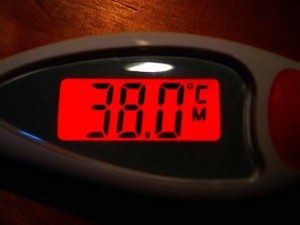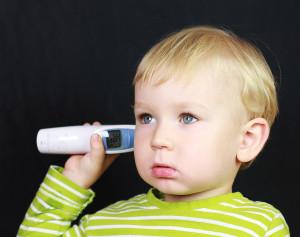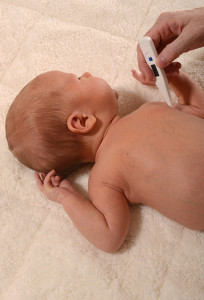How Many Degrees Do You Add to Underarm Temp

It is important to properly take a temperature with whatever method you choose, as if it is done incorrectly, the reading may be inaccurate and will generally read lower than the true temperature.
What is a Fever?
A fever is considered to be a rectal, ear or temporal artery temperature of 100.4ºF (38ºC) or higher.
If you are using an oral or oral pacifier thermometer, many doctors would say that a fever is also over 100.4ºF (38ºC), but some may consider a fever in a young patient, to be an oral temperature of 100ºF or 37.8ºC. Talk to your doctor about what temperature range they would consider a fever and about the recommended treatment.
With the axillary (armpit) temperature, a fever is present if the reading is 99.4ºF or higher, or over 37.2ºC, but others consider 99.0ºF to be a fever, depending on your doctor's recommendation.
Keep in mind, for these systemic autoinflammatory diseases, it's not just a fever. With that rise in temperature comes inflammation in various parts of the body. You or your child may "only" be at 99.5 degrees F, but feel miserable. Therefore symptoms and how you or your child feels need to be considered as well when making treatment decisions. Also, if you are on prescribed medications, such as NSAIDS for your disease, your body may not manifest a temperature over what is considered to be a fever, but you could still be symptomatic.
Click here to read more about Normal Body Temperature and the Periodic Fever Syndromes.
Which Temperature Taking Method Should You Use?
The key to deciding how to take a temperature is to choose a method that you and/or your doctor are most comfortable with and use it every time. You want to be consistent when taking yours or your child's temperature. Switching thermometer types and trying to compare different methods each time you take a temperature will only get confusing. Use the same type of thermometer every time and get to know what a normal temperature range is for you or your child when not in a flare and when in a flare using that one method.
Also, follow the directions that come with whatever thermometer you choose, and if it uses batteries, be aware that if it is starting to be inconsistent with readings, it may be time to change the battery. If it continues to not work right, get a new one, as you need a reliable, accurate and consistent method of taking temperatures.
Here are some tips on using the various thermometers:

Studies show ear thermometer temperatures are comparable to rectal temperatures.
Tympanic (Ear) Thermometers
Tympanic temperature readings average about the same as rectal.
Take the temperature in both ears and use the highest reading unless you or your child has been laying on that ear.
Several things can affect the reading in the ear including laying on one ear, an ear infection, wax build up, and angle of the thermometer.
For some individuals, this method is not the best. According to the Mayo Clinic, those with a "small, curved ear canal" will have inaccurate readings.
Temporal Artery Thermometers
Temporal thermometer readings average about the same as rectal and ear thermometer readings in some studies, but lower in others. These thermometers seem to have the most inconsistencies in how they compare to other methods. Differences may be due to which brand was used in the study and if the patients were febrile or healthy. Also, incorrect use of these thermometers will make them inaccurate.
Be sure to read the instructions as these have a specific method of use. For example, the Exergen forehead thermometer requires that you scan the forehead and artery behind the ear while holding the button down the entire time. Lifting off the button too soon will give you a lower reading.
The following video demonstrates how to use the Exergen forehead thermometer:
Oral/Rectal/Axillary Digital Thermometers
In the past, people used glass mercury thermometers, but this is now not recommended, and they should be disposed of at a proper collection facility. There are a number of safe, and accurate ways to take a temperature available that are preferred for patients.
Oral and axillary temperatures average about .5 F to 1.0 F (.3 C to .6 C) degrees below rectal, ear, and temporal readings. Add .5 to 1.0 when taking orally or under the arm to determine the comparable rectal temperature.
Eating and drinking can affect the accuracy when taking an oral temperature. Wait 15 to 30 minutes after eating and drinking before taking an oral temperature.
Axillary, where you measure the temperature under the armpit, can be less reliable for getting an accurate body temperature, and can register up to a degree lower than rectal or other methods of taking the internal temperature. But it is still considered acceptable if done correctly and is used in many hospitals.
This method can be done more accurately if the thermometer is properly placed in the deepest pit part of the axilla (armpit), and held in that place, with the arm folded down and over the thermometer, until the thermometer is done testing the temperature. This method is the most used by a number of patients, since a temperature can be done with any digital or standard (non-mercury) thermometer, and the least expensive thermometer on the market. It may also be the most convenient for travel, since they are small and easy to replace.
A rectal temperature is generally considered to be the most accurate, and the standard for monitoring the core body temperature, but it is generally not recommended for use in patients, due to the risk of rectal perforation and tears with this method.
Have a separate thermometer to use for oral than for rectal.

Taking the temperature under the armpit is safer than rectal. Add .5 to 1.0 F or .3 to .6 C to the reading when taking axillary temperatures. Photo by ftlaudgirl/Bigstockphoto.com
Age Considerations
Newborn to 6 months
Use an axillary or temporal thermometer with newborns and young babies. The ear thermometer will most likely be too big for a newborn baby. The pacifier thermometers may work for some, but babies tend to spit these out long before an accurate reading can be made.
Toddler and young children
Tympanic, temporal artery, or axillary temperatures are the best methods for this age group. Oral may be difficult in some younger children because they often will bite on the thermometer, and may not keep it properly in place in the mouth.
Teen and Adult Women
A woman's temperature fluctuates normally with her menstrual cycle and will be higher near ovulation and lower the rest of the cycle.
Time of Day
The time of day will make a difference in body temperature. Typically your temperature is lowest in the morning before you get out of bed. Temperatures will naturally rise throughout the day and change based on your activity level.
What if the Temperature Changes?
It is normal in any of these methods to get various readings, even when taking the temperature multiple times within just a few minutes. Our body temperature normally fluctuates and you may get a difference of a full degree or more in just a few minutes or in the case of ear thermometers, between the left and right ears. And this does seem to happen often for some with fever disorders while in a flare. Know that this is normal, but if you are not confident that you are getting an accurate reading, try another method or thermometer.

When taking a temperature, always record the temperature and any other symptoms. Photo by art_of_sun/Bigstockphoto.com
Tips for Temperature Logging
When monitoring daily temperature for your symptom journal, it is best to take the baseline temperature at the same time of day, generally in the morning. You can take it more often, and at other times of the day as needed, but consistency is the key for monitoring daily, and between flares.
Also, if you get a high or low reading, re-take the temperature! It may be correct, but it is best to confirm the temperature if it is unusual, and the doctor will ask you if you did take it again, as sometimes there are errors with thermometers, or technique in taking the temperature.
You want to have the most accurate information for your daily symptom logs, so if you need to do more than one temperature to get an accurate reading, or repeat it again later, make sure to record these too. Most of the time, you will not need to do more than one temperature a day, if no disease flares or symptoms are present, but you may need to do more frequent temperatures on days with disease flares.
Click here for reviews of some of the best thermometers for fever syndromes.
References
- Mayo Clinic: Thermometer basics: Taking your child's temperature
- PubMed.gov: Clinical Accuracy of Tympanic Thermometer and Noncontact Infrared Skin Thermometer in Pediatric Practice: An Alternative for Axillary Digital Thermometer.
- PubMed.gov: Investigating relationships among five temperature measurement sites in newborns
- PubMed.gov: Comparison of rectal, axillary, tympanic, and temporal artery thermometry in the pediatric emergency room.
- PubMed.gov: Can we trust the new generation of infrared tympanic thermometers in clinical practice?
- PubMed.gov: Are Temporal Artery Temperatures Accurate Enough to Replace Rectal Temperature Measurement in Pediatric ED Patients?
- PubMed.gov: A systematic review of the accuracy of peripheral thermometry in estimating core temperatures among febrile critically ill patients.
- MedinePlus: Fever
- Differences in noninvasive thermometer measurements in the adult emergency department.
- Evaluation of temporal artery and disposable digital oral thermometers in acutely ill patients.
- Comparison of body temperatures in children measured using 3 different thermometers: tympanic, skin and digital axillary
- UpToDate: Patient education: Fever in children (Beyond the Basics)
- Seattle Children's: Fever – Myths Versus Facts
*Updated 8/18/15.
*Child taking ear temperature photo by greenland/Bigstockphoto.com.
More for You
How Many Degrees Do You Add to Underarm Temp
Source: http://saidsupport.org/what-is-the-most-accurate-way-to-take-a-temperature-is-oral-temporal-ear-or-rectal-best/
0 Response to "How Many Degrees Do You Add to Underarm Temp"
Post a Comment